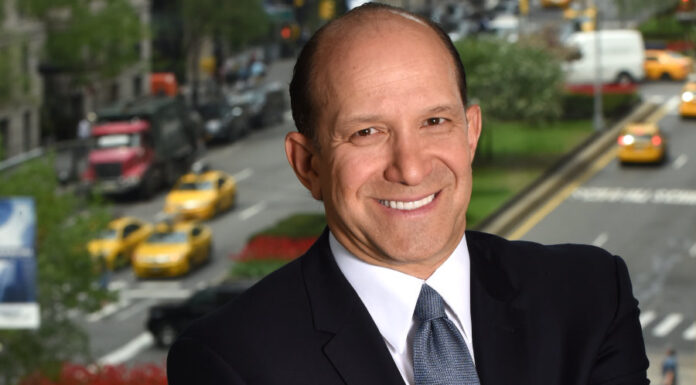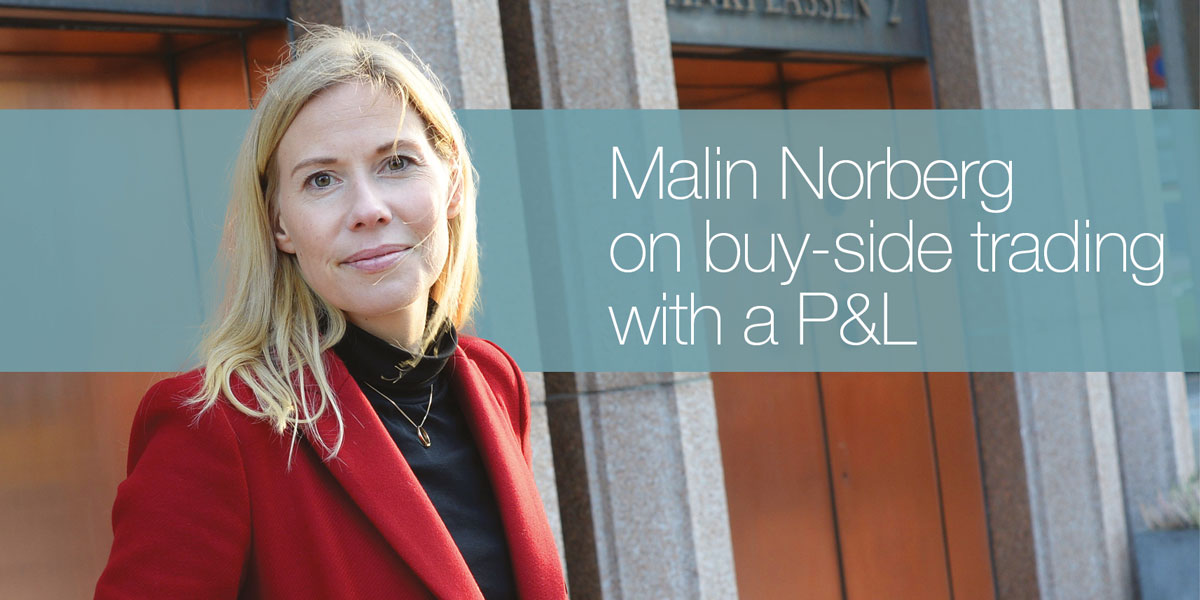
Norges Bank Investment Management’s almost unique position, managing a fund with a single owner, allows it a very innovative way of trading into the market.
All trading in the fund is divided into equity trading and fixed income and FX trading. The team that I manage consists of 14 people sitting in Singapore, Oslo, London and New York, covering everything from credit to emerging, developed market rates and derivatives. We also trade the FX for the whole fund, including from the equity side. So, we are divided into an FX team, credit team and a rates team. Most of the traders that we have are very senior, and many have worked on the fund for a long time either as traders the entire time, but some of them come from the portfolio management (PM) side or risk parts of the fund.
There is a lot of internal mobility. We just hired a new trader who comes from the technology side actually. And many of the traders have also worked on the sell side before, so that’s a very valuable experience.
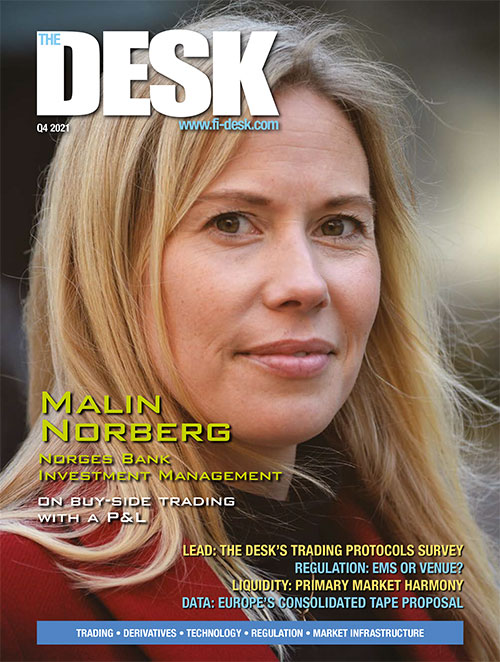 How would you characterise the teams existing skill sets, and how do you see those skills changing?
How would you characterise the teams existing skill sets, and how do you see those skills changing?
We have seen that markets are developing more rapidly, and they are more complex. So, we have seen the need to become more specialised to have an edge in the markets that we trade in. Before, we used to trade a bit of everything, but now we have specialised traders for the different asset classes. We have also moved more risk taking to the trading desk, so we are very far from an execution desk. We have autonomy on when, with who and how the trade is executed, and we usually also own the P&L of that execution. So, that’s where market making experience is of course really important to have. And then it’s of course the technical side of things and that’s developing quite fast. So, there we have to rely on the support from the rest of the organisation. But we also see a number of traders taking Python classes and actually using that in their work.
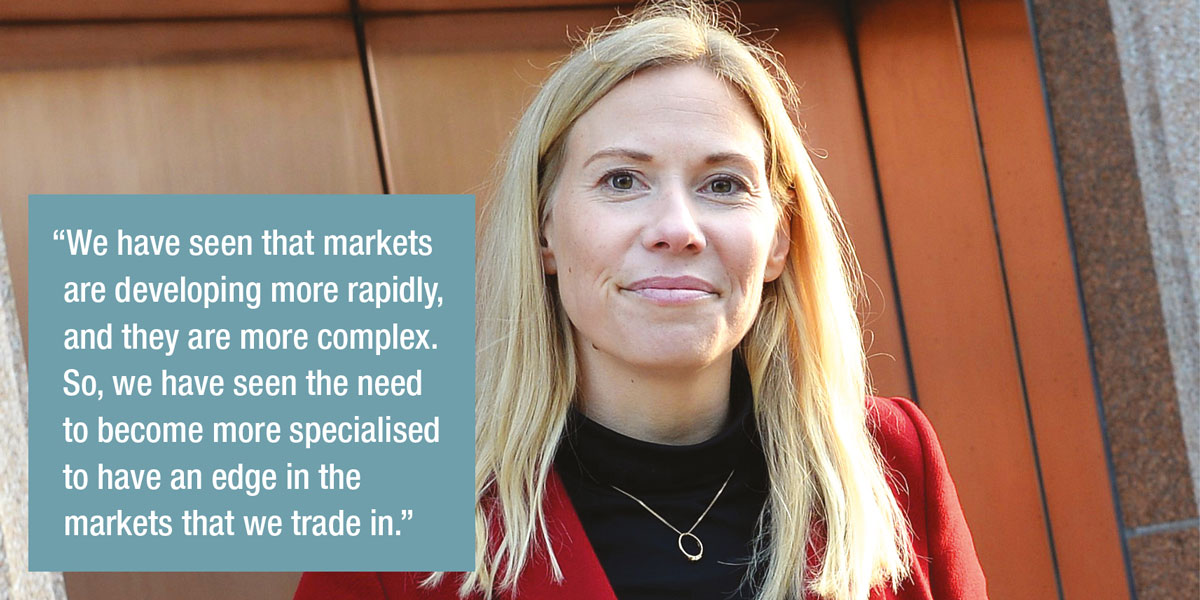
Do the skills they need relate more to quantitative trading than the qualitative approach that has historically been dominant?
I think fixed income trading has always been and will always be qualitative. It’s a principal-to-principal business and it’s never going to be fully equity-like, but I do think there is a lot more data available that you can use for making decisions. To actually make use of that data, to get it into our decision making process, those skills are much needed.
Managing this team how would you describe your leadership approach?
Good management is about mutual trust and creating a collaborative environment for people to have room to use their individual competencies and skill sets. Given the seniority and experience that the trading team has, and in addition it’s very geographically spread out over the world, it is naturally a very autonomous team where each person has a lot of freedom, and a lot of responsibility. I am not in this role because I know how to trade every market the best, but my job is to listen to people and understand what they need to perform at their best. So, my biggest task is to facilitate that, to make sure we get the support that we need from the rest of the organisation. I need to make sure we have the tools that we need, we have the counterparties and we have the right people in the right seats to enable us to do the best job.
Do you trade as well as manage?
Up until a year ago I was trading EM rates in CEEMA as head of EM debt trading I still do that – not as much – but I still trade it. And I think it is important to keep a little bit of that to keep in touch with the markets, as much as sitting in meetings all day. It just might feel like that sometimes! You don’t see [trading in] the same way, you can look at all the charts, but if you don’t have any skin in the game you are not going to feel it.”
What are your key three strategic objectives over the next 12 months?
Firstly, when we published our official strategy plan earlier this year, there is a section on our ability to implement fixed income investments at low cost. One of the other points that we mentioned [in the report] is, increased use of standard derivatives [and streamlining our processes to facilitate for that]. We are mainly a cash house and we will probably continue to be, but we do see increased use of derivatives across all markets as these instruments are all usually more liquid and they enable you to trade in size, and risk, quickly. With trading risk, our size can be a problem sometimes. And also with QE present across most markets you see that derivatives have been less affected by that, than cash bonds have.
Secondly, something on everyone’s mind is technology development. We have a fairly basic order management systems (OMS). To keep up with the market and take advantage of the technological development that is out there, we are building more in-house [capability] to handle orders better, and to make better decisions, integrating internal and external data to use that for decision making, and to streamline processes in areas such as primary markets. That is a big thing that we are focussing on.
Thirdly, I would love for the team to actually be able to meet in person again in the next 12 months, get together and discuss ideas and hang out. We have been back to the office in Oslo now and you can really see how much that is affecting discussions, and ability to come up with ideas and just the way the enthusiasm of people.
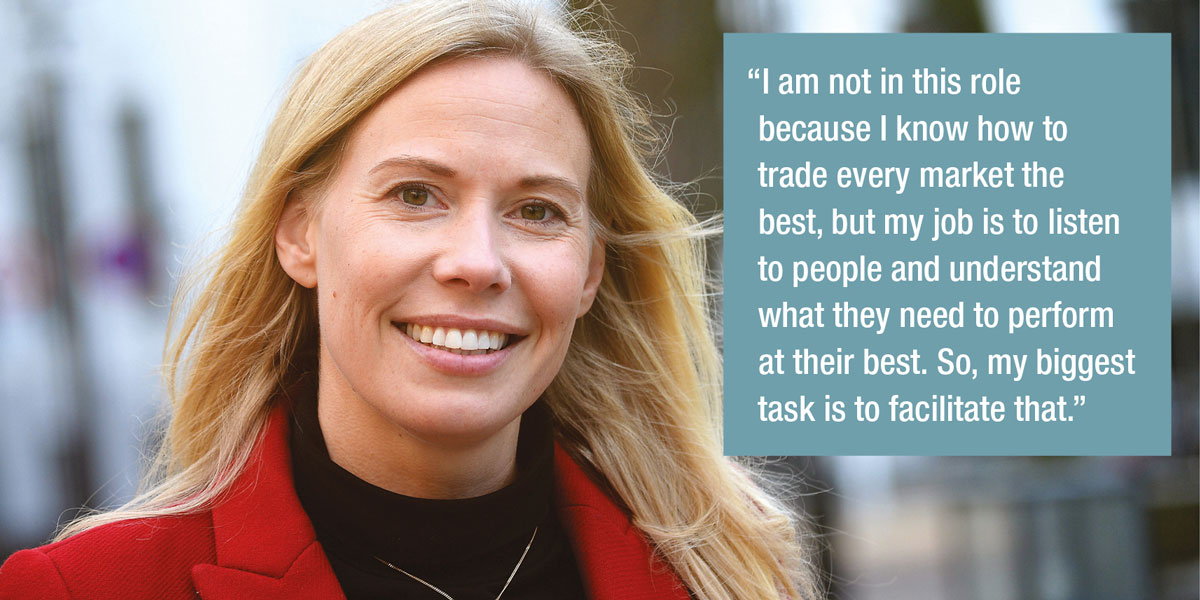
Which geographies do your teams cover and which instruments do they cover within the asset classes you mentioned?
The fixed income trading team covers all regions and instruments we trade in FI and FX. We are fairly conservative in the instruments we use. So, on the fixed income side it is primarily cash bonds. We trade centrally cleared derivatives – interest rate swaps (IRS), inflation swaps, CDX, iTraxx and futures. But that is about it. The fund gets its mandate from the Norwegian Ministry of Finance and we are benchmarked to a customised version of the Barclays-Bloomberg index globally. In terms of currency, in credit it is mainly dollar, euro and sterling and some smaller currencies. On the rates side we do invest in a broader universe including emerging markets. Although emerging markets went out of our index a while ago it’s still something that we invest in. It’s just more of an active allocation.
Could you outline the investment strategies used, and how that affects your approach to trading?
We have the mandates from the Ministry of Finance and we are benchmarked to an index. The fund has some unique features that sets it apart from most other investors; the size, the extremely long-term horizon and the fact that we only have one owner. That means we are not going to have unexpected in- or outflows that we have to be prepared for. Any P&L from centralised activities such as trading doesn’t have to be attributed back to any one account. This allows for us to do things differently from other investment managers, and think about what is best for the fund as a whole. That puts us in a very interesting position. So, while the trading desk is working very closely with the PMs to provide market colour and generate ideas, we are also very autonomous in the sense that we have full responsibility for execution in the market.
Could you give us an example of how that works?
We have internal risk pricing books that we use when portfolio managers want to do a secondary trade in the market in FX and credit. So, the trading desk provides them with a price that’s usually a better price than we get in the market for that type of size. And the PM order gets immediately filled, and then the trader owns that position. A similar approach is also used for implementations related to benchmark changes. In addition to that, on the trading desk we have our own liquidity provisioning portfolios, where we can take positions based on short term dislocations in the market. So, things that wouldn’t necessarily fit into the PMs’ portfolios. And we have seen by structuring the trading desk like this, it becomes much more than just an execution desk. So, we are actually a profit centre for the fund. And also that by being constantly active in the market, and having one’s own portfolio we have seen also makes the traders so much sharper and in tune with the market. That is of course benefiting PMs and the fund.
That’s really interesting – we have not seen a set-up like that before.
I think the problem for most other buy side firms, why they can’t do it, is because they need to prove best execution for the P&L of a specific trade, to go back to the mandate, etc. Since we have one owner all the P&L goes into the same basket. You have a little more freedom on how you do things. I think it’s much more interesting to be a trader, because you are actually responsible for the P&L. It’s not just about the best execution because we are not really bound by those rules. So, it’s just what is the best for the fund. If you have your own P&L of course you want the best execution. But maybe not just the best execution for that clip that you are going to do, but the best execution for the big trade, or for the fund.
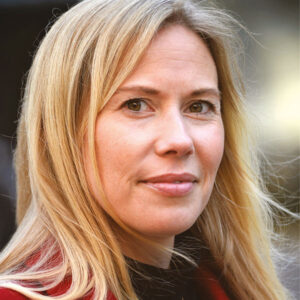 How are you are seeing changes within your counterparty make up?
How are you are seeing changes within your counterparty make up?
So far we mostly have bank counterparties. But we do see that non-bank and other buy side might become more important going forward. That landscape is changing. The past two years has showed us how important it is to keep a good and close relationship with your counterparties so that if liquidity dries up you do have that trust, and you are able to support each other to get trades done. Our set-up on the trading desk has evolved to being more of a liquidity provider than a liquidity taker. We have seen that the most successful counterparties are the ones who put some effort into understanding how we operate. There is less risk-taking ability on the sell side, so what often happens is that banks show blocks into us, that they might not have the capacity to take onto their own books. And on the trading desk we have the autonomy and the risk taking ability to react to these axes, we don’t have to go back to ask a PM if they want to do something, get approval, and come back three hours later with the response.
Has your broker list been changing in size or composition?
We have never had a huge broker list because if you have too many on the list it’s hard to give them some meaningful flow, and to have a meaningful relationship. In some of the emerging markets we have local counterparties that are specialised in that market. But we are fairly restrictive on which counterparties we choose to add, because reputational risk is a thing that we care a lot about, so, we want to make sure that we know who our counterparties are.
What sort of tools do you use on the desk?
Our PMS/OMS set-up is pretty basic, it’s not really a tool for decision making. We are building things in-house to be able to integrate the different data sources of Bloomberg axes and runs and actually get that into our own environment. It is very much a work in progress, and it’s tough to keep up with the market development. Live streaming prices is something that we will probably see coming more. So, far we only have that for FX but we will probably see it on the fixed income side too in not too long. But of course historical data such as a consolidated tape would be very helpful if that existed, as it exists in the US. The other tool that we use a lot for getting a grasp on liquidity in the market is liquidity provisioning mandates that we have on the trading desk. So, actually being active in the market allowing us to get a feel for how liquidity is, where the market is trending, what is going on. And it allows you to get better prepared for the next big trade.
Do you have any views on some of the pre-trade liquidity tools out there?
There are so many that are trying, and we have looked at a lot of them but we haven’t really found one that stuck or that fits really well into what we do. We currently don’t have an EMS on the fixed income side, I think the offerings out there they are becoming much better, but they so far haven’t really been mature enough for us to see the full value. It’s moving so fast, it’s probably time to make a new review of what is out there. So far we haven’t found anything that really works for us, hence the in-house development.
We see building in-house becoming more common.
It is, and you can build everything exactly as you want it. But of course it’s a lot of work building and maintaining that. So, the question is how far you want to take that.
How do the traders add value to the investment process?
First of all is that we actually add value through our trading set up as described, but on the fixed income side we are working very close with the PM team. So, it’s an investment team set up in each region, that includes PMs and traders where all the members have responsibility for the portfolio and to be part of the discussion and fund positioning. It’s very much a team effort on the portfolio. So, of course we do more of the market-oriented stuff, what is going on in the market, and then maybe look more at macro trends. But put together it’s working very well as a team effort.
How do you communicate between trading teams and portfolio managers and counterparties?
We are a big firm in terms of asset management, but in the number of people we are fairly small. So, everyone who works in something fixed income related is probably around 50 people across all the offices. We sit together in one room in each one of the offices, so we do have constant conversations about the market, positioning, etc, in person and also over Teams. That has become more electronic during the pandemic. That has actually had some positive effects because it’s easier to include people from other offices when you do things partly electronically as well. But all the formal sending of orders and instruction goes through our PMS/OMS and it’s also communicated over Bloomberg.
What barriers are your traders facing in price formation and liquidity formation?
The way we have been tackling this is putting a lot of work and effort into building the relationship and trust with counterparties through everyday trading, and the way we share information and execute trades, but also through actually making an effort and visiting the markets locally, and meeting someone face-to-face and talking to local institutions and offshore investors. It is a lot of work, but you can’t really know if you are only at your desk.
You have mentioned bringing derivatives into use more, is the macro situation with fixed income markets, including the sell side reduction of risk trading creating a dynamic that you have to address?
In many places liquidity in cash bonds is going down a bit and from what I understand more and more real money investors use derivatives to a larger extent. They have allocated the allocation to cash bonds but use it as more of an active positioning tool. So, I think it is being addressed and it will be interesting to see if that changes when and ‘if’ sell-side balance sheets are expanding, and QE winds down.
What is your vision for the trading desk, and how would it change from today?
Fixed income trading has always been principal to principal market, your relationships and your risk taking ability are the most important things. So, no doubt that this will continue being important components in the future. But given how much more important it’s getting with the technology and data analytics, it makes less sense to keep them as a siloed support functions. I think they will have to be more integrated into our processes, and into our business and how we work. I think they can really help us and improve how we do things and enable us to do a better job in trading.
What changes would you make to market structure and the provision of services and tools to yourselves if you could?
Of course, a really ground-breaking EMS would be a great improvement. We are a long-term, large investor, and we have always been involved in a well-functioning market. The most topical thing here in Europe now is the new regulation around transparency, and creation of a consolidated tape. So, this is really important, a lot of the new trends around automation and making things more electronic depend on this. And we are playing an active role in this development. From our standpoint more transparency, and even it sounds scary to begin with for some market participants, will ultimately benefit the market and improve liquidity. With the UK and Europe working on different paths now, I really hope this will not bring them too far apart.












